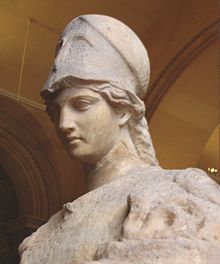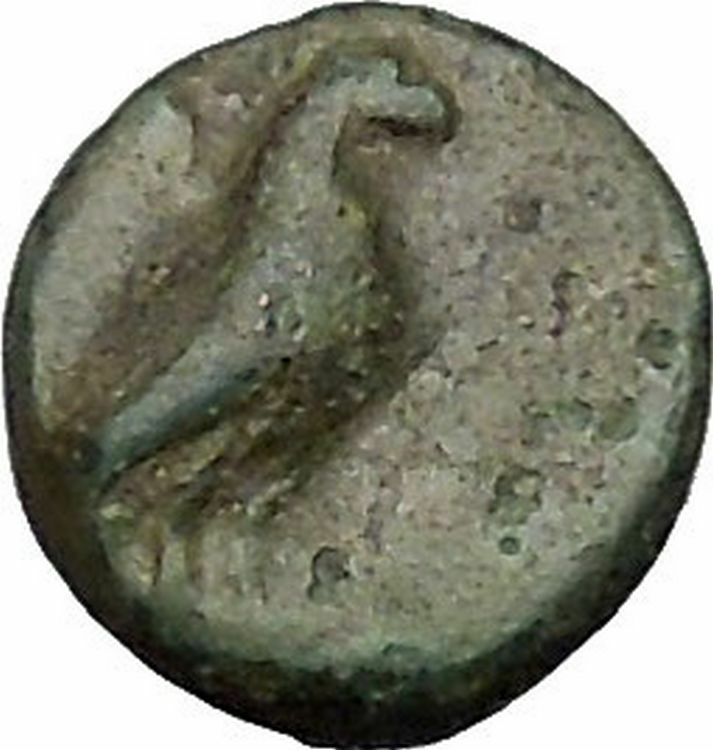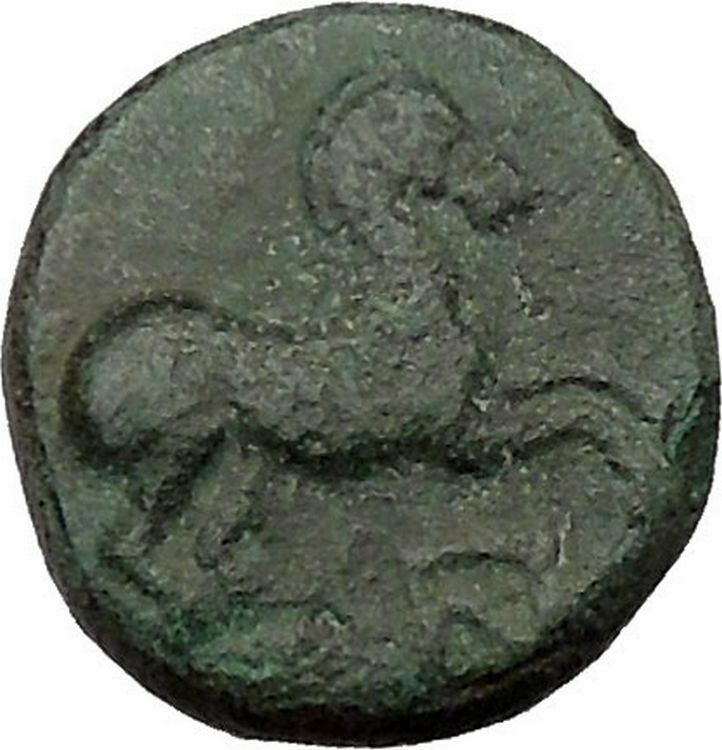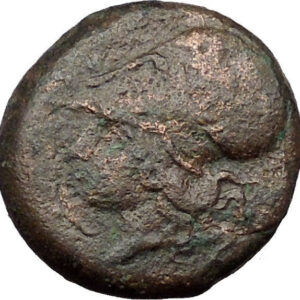|
Greek City of Pergamon in Asia Minor
Regal Bronze Coinage of Pergamon
Bronze 13mm (1.88 grams) Struck circa 282-133 B.C.
Reference: Sear 7233
Head of Athena right, wearing crested Corinthian helmet.
ΦΙΛE TAIPOY above and beneath bow.
This issue is inscribed with the name of
the dynasty’s founder, Philetairos, and firm
attributions
to particular reigns
are not yet possible.
Situated in the Kaikos valley, about 15 miles from the
coast, Pergamon was a city of uncertain origin and of no great importance before
the time of Alexander the Great. In the 3rd century B.C. it became the center of
the independent kingdom ruled by the Attalid dynasty founded by Philetairos. The
city was extended and beautified as the prosperity of the kingdom increased, and
by the late Hellenistic times Pergamon ranked as one of the great cultural
centers of the Greek world. After the end of the kingdom, 133 B.C., Pergamon
became capital of the Roman province of Asia.
You are bidding on the exact item pictured,
provided with a Certificate of Authenticity and Lifetime Guarantee of
Authenticity.
The bow and arrow is a projectile
weapon
system (a bow with
arrows
) that predates
recorded history
and is common to most
cultures
.
Archery
is the art, practice, or skill of
applying it.

Description
A bow is a flexible arc which shoots aerodynamic projectiles called
arrows
. A string joins the two ends of the bow
and when the string is drawn back, the ends of the bow are flexed. When the
string is released, the potential energy of the flexed stick is transformed into
the velocity of the arrow.
Archery
is the art or sport of shooting arrows
from bows.
Today, bows and arrows are used primarily for
hunting
and for the sport of
archery
. Though they are still occasionally
used as weapons of war
, the development of
gunpowder
and
muskets
, and the growing size of armies, led to
their replacement in warfare several centuries ago in much of the world.
Someone who makes bows is known as a
bowyer
, and one who makes arrows is a
fletcher
—or in the case of the manufacture of
metal arrow heads, an arrow smith.
History

Scythians
shooting with bows,
Panticapeum
(known today as
Kertch
,
Ukraine
), 4th century BCE.
The bow and arrow is among the oldest composite projectile weapons invented;
only
spear throwers
and
darts
may predate it, having been in use since
30,000 BCE, with the oldest example from 17,500 BCE. However, despite its
ancient provenance, a number of cultures in historical times lacked the bow and
arrow, and in others
oral history
records a time before its
acquisition.
The earliest potential arrow heads date from about 64,000 years ago in the
South African
Sibudu Cave
, though their identification as
arrowheads (as opposed to
spear
or
dart
heads) is uncertain. The first actual bow
fragments are the Stellmoor bows from northern Germany. They were dated to about
8,000 BCE but were destroyed in
Hamburg
during the Second World War, before
carbon 14 dating
was available; their age is
attributed by archaeological association. The oldest bows in one piece are the
elm
Holmegaard bows
from
Denmark
which were dated to 9,000 BCE. High
performance wooden bows are currently made following the Holmegaard design.
The bow and arrow are still used in tribal warfare in
Africa
to this day. An example was documented
in 2009 in Kenya
when the
Kisii-tribe
and
Kalenjin-tribe
clashed resulting in four
deaths.
Construction

Polychrome small-scale model of the archer XI of the west pediment
of the
Temple of Aphaea
, ca. 505–500 BCE.
Parts of the bow
The basic elements of a bow are a pair of curved
elastic
limbs
, traditionally made from
wood, joined by a riser. Both ends of the limbs are connected by a
string known as the
bow string
. By pulling the string backwards the
archer
exerts
compressive force
on the string-facing section,
or
belly
, of the limbs as well as placing the
outer section, or
back
, under
tension
. While the string is held, this stores
the energy later released in putting the arrow to flight.[citation
needed] The force required to hold the string
stationary at full draw is often used to express the power of a bow, and is
known as its draw weight, or weight. Other things being equal, a higher draw
weight means a more powerful bow, which is able to project arrows heavier,
faster, or a greater distance.
The various parts of the bow can be subdivided into further sections. The
topmost limb is known as the upper limb, while the bottom limb is the lower
limb. At the tip of each limb is a nock, which is used to attach the bowstring
to the limbs. The riser is usually divided into the grip, which is held by the
archer, as well as the arrow rest and the bow window. The arrow rest is a small
ledge or extension above the grip which the arrow rests upon while being aimed.
The bow window is that part of the riser above the grip, which contains the
arrow rest.
In bows drawn and held by hand, the maximum draw weight is determined by the
strength of the archer. The maximum distance the string could be displaced and
thus the longest arrow that could be loosed from it, a bow’s draw length, is
determined by the size of the archer.
A composite bow
uses a combination of materials
to create the limbs, allowing the use of materials specialized for the different
functions of a bow limb. The classic composite bow uses wood for lightness and
dimensional stability in the core, horn to store energy in compression, and
sinew
for its ability to store energy in
tension. Such bows, typically Asian, would often use a stiff end on the limb
end, having the effect of a recurve.[16]
In this type of bow, this is known by the Arabic name ‘siyah’.
Modern construction materials for bows include
laminated
wood,
fiberglass
,
metals
, and
carbon fiber
components.
Arrows
An arrow usually consists of a shaft with an arrowhead attached to the front
end, with fletchings and a nock at the other. Modern arrows are usually made
from carbon fibre, aluminum, fiberglass, and wood shafts. Carbon shafts have the
advantage that they do not bend or warp, but they can often be too light weight
to shoot from some bows and are expensive. Aluminum shafts are less expensive
than carbon shafts, but they can bend and warp from use. Wood shafts are the
least expensive option but often will not be identical in weight and size to
each other and break more often than the other types of shafts. Arrow sizes vary
greatly across cultures and range from very short ones that require the use of
special equipment to be shot to ones in use in the
Amazon River
jungles that are 8.5 feet (2.6
metres) long. Most modern arrows are 22 inches (56 cm) to 30 inches (76 cm) in
length.
Arrows come in many types, among which are breasted, bob-tailed, barrelled,
clout, and target. A breasted arrow is thickest at the area right behind the
fletchings, and tapers towards the nock and head. A bob-tailed arrow is thickest
right behind the head, and tapers to the nock. A barrelled arrow is thickest in
the centre of the arrow. Target arrows are those arrows used for target shooting
rather than warfare or hunting, and usually have simple arrowheads.
Arrowheads
The end of the arrow that is designed to hit the target is called the
arrowhead. Usually, these are separate items that are attached to the arrow
shaft by either tangs or sockets. Materials used in the past for arrowheads
include flint, bone, horn, or metal. Most modern arrowheads are made of steel,
but wood and other traditional materials are still used occasionally. A number
of different types of arrowheads are known, with the most common being
bodkins
, broadheads, and piles. Bodkin heads
are simple spikes made of metal of various shapes, designed to pierce armour. A
broadhead arrowhead is usually triangular or leaf-shaped and has a sharpened
edge or edges. Broadheads are commonly used for hunting. A pile arrowhead is a
simple metal cone, either sharpened to a point or somewhat blunt, that is used
mainly for target shooting. A pile head is the same diameter as the arrow shaft
and is usually just fitted over the tip of the arrow. Other heads are known,
including the blunt head, which is flat at the end and is used for hunting small
game or birds, and is designed to not pierce the target nor embed itself in
trees or other objects and make recovery difficult. Another type of arrowhead is
a barbed head, usually used in warfare or hunting.
Bowstrings
Bowstrings may have a nocking point marked on them, which serves to mark
where the arrow is fitted to the bowstring before firing. The area around the
nocking point is usually bound with thread to protect the area around the
nocking point from wear by the archer’s hands. This section is called the
serving. At one end of the bowstring a loop is formed, which is permanent. The
other end of the bowstring also has a loop, but this is not permanently formed
into the bowstring but is constructed by tying a knot into the string to form a
loop. Traditionally this knot is known as the archer’s knot, but is a form of
the timber hitch
. The knot can be adjusted to
lengthen or shorten the bowstring. The adjustable loop is known as the “tail”.
Bowstrings have been constructed of many materials throughout history,
including fibres such as
flax, silk
, and
hemp. Other materials used were animal
guts
, animal
sinews
, and
rawhide
. Modern fibres such as
Dacron
or
Kevlar
are now used in bowstring construction,
as well as steel wires in some compound bows.
Compound bows
have a mechanical system of
pulley cams over which the bowstring is wound.
Types of bows
There is no one accepted system of classification of bows. Some systems
classify bows as either longbows or composite bows. In this system, a longbow is
any bow that is made from one material. Composite bows are made from two or more
layers of different materials. Other classifications divide bows into three
types — simple, backed, and composite. In this scheme, simple bows are made of
one material, backed bows are made of two layers, which could be similar or
different materials. Composite bows are made of three different layers, usually
different materials, but occasionally two of the layers are made from the same
material.
Common types of bow include
-
Recurve bow
: a bow with the tips curving
away from the archer. The curves straighten out as the bow is drawn and the
return of the tip to its curved state after release of the arrow adds extra
velocity to the arrow.
-
Reflex bow
: a bow that curves completely
away from the archer when unstrung. The curves are opposite to the direction
in which the bow flexes while drawn.
- Self bow
: a bow made from one piece of
wood.
- Longbow
: a self bow that is usually quite
long, often over 5 feet (1.5 metres) long. The traditional
English longbow
was usually made of
yew
wood, but other woods are used also.
-
Composite bow
: a bow made of more than one
material
-
Compound
: a bow with mechanical aids to
help with drawing the bowstring. Usually, these aids are pulleys at the tips
of the limbs.
Crossbow
In a crossbow
, the limbs of the bow, called a
prod, are attached at right angles to a crosspiece or
stock
in order to allow for mechanical pulling
and holding of the string. The mechanism that holds the drawn string has a
release or trigger that allows the string to be released. A crossbow shoots a
“bolt” rather than an arrow.
Athena or Athene
(Latin:
Minerva
), also referred to as
Pallas Athena, is the goddess of war, civilization, wisdom, strength,
strategy, crafts, justice and skill in
Greek mythology
.
Minerva
,
Athena’s Roman

incarnation,
embodies similar attributes. Athena is also a shrewd companion of
heroes and the
goddess
of
heroic endeavour. She is the
virgin
patron of
Athens
. The Athenians built the
Parthenon
on the Acropolis of her namesake
city, Athens, in her honour (Athena Parthenos). Athena’s cult as the patron of
Athens seems to have existed from the earliest times and was so persistent that
archaic myths about her were recast to adapt to cultural changes. In her role as
a protector of the city (polis),
many people throughout the Greek world worshiped Athena as Athena Polias
(“Athena of the city”).
Athens
and Athena bear etymologically connected
names.
Pergamon, Pergamum or Pérgamo (in
Greek
, Î ÎÏ�γαμος) was an ancient
Greek
city in modern-day
Turkey
, in
Mysia
, today
located 16 miles (26 km) from the
Aegean Sea
on a promontory
on the north side of the river
Caicus
(modern day
Bakırçay
),
that became the capital of the
Kingdom of Pergamon
during the
Hellenistic period
, under the
Attalid dynasty
, 281–133 BC. Today, the main sites of ancient Pergamon are
to the north and west of the modern city of
Bergama
.
//
History

The
Kingdom of Pergamon
(colored olive), shown at its
greatest extent in
188 BC
The
Attalid
kingdom was the
rump state
left after the collapse of the
Kingdom of Thrace
.
The Attalids, the descendants of Attalus, father of
Philetaerus
who came to power in 281 BC following the collapse of the
Kingdom of Thrace, were among the most loyal supporters of
Rome
in the Hellenistic world. Under
Attalus I
(241-197 BC), they allied with Rome against
Philip V of Macedon
, during the
first
and
second
Macedonian Wars
, and again under
Eumenes II
(197-158 BC), against
Perseus of Macedon
, during the
Third Macedonian War
. For support against the
Seleucids
, the
Attalids
were rewarded with all the former Seleucid domains in
Asia Minor
.
The Attalids ruled with intelligence and generosity. Many documents survive
showing how the Attalids would support the growth of towns through sending in
skilled artisans and by remitting taxes. They allowed the Greek cities in their
domains to maintain nominal independence. They sent gifts to Greek cultural
sites like Delphi
,
Delos
, and
Athens
. They
defeated the invading Celts
. They remodeled the
Acropolis of Pergamo
after the
Acropolis
in Athens. When
Attalus III
(138-133 BC) died without an heir in 133 BC he bequeathed the
whole of Pergamon to Rome, in order to prevent a civil war.
According to Christian tradition, the first bishop of Pergamon,
Antipas
, was martyred there in ca. 92 AD. (Revelation
2:13)
The
Ottoman
Sultan
Murad III
had two large alabaster
urns transported from the ruins of Pergamon and placed on two
sides of the nave in the
Hagia
Sophia
in Istanbul
.[1]
Notable
structures
Upper
Acropolis

The Great Altar of Pergamon, on display in the
Pergamonmuseum
in
Berlin
,
Germany

Model of the Acropolis in the Pergamonmuseum in Berlin

Sketched reconstruction of ancient Pergamon
The
Great Altar of Pergamon
is in the
Pergamon Museum
, Berlin. The base of this altar remains on the upper part of
the Acropolis. It was perhaps to this altar, believed dedicated to Zeus, that
John of Patmos referred to as “Satan’s Throne” in his Book of Revelation
(Revelation 2:12-13).
Other notable structures still in existence on the upper part of the
Acropolis include:
Pergamon’s library on the Acropolis (the ancient
Library of Pergamum
) is the second best in the ancient Greek civilization.[4]
When the
Ptolemies
stopped exporting
papyrus
,
partly because of competitors and partly because of shortages, the Pergamenes
invented a new substance to use in
codices
, called
pergaminus or pergamena (parchment)
after the city. This was made of fine
calfskin
, a
predecessor of
vellum
. The library at Pergamom was believed to contain 200,000 volumes,
which Mark Antony
later gave to
Cleopatra
as a wedding present.
Lower
Acropolis
The lower part of the Acropolis has the following structures:
- the Upper Gymnasium
- the Middle Gymnasium
- the Lower Gymnasium
- the Temple of
Demeter
- the Sanctuary of
Hera
- the House of Attalus
- the Lower Agora and
- the Gate of
Eumenes
Sanctuary
of Asclepius
Three kilometers south of the Acropolis, down in the valley, there was the
Sanctuary of Asclepius
(also known as the
Asclepieion
), the god of healing. In this place people with health problems
could bathe in the water of the sacred spring, and in the patients’ dreams
Asclepius would appear in a vision to tell them how to cure their illness.
Archeology has found lots of gifts and dedications that people would make
afterwards, such as small terracotta body parts, no doubt representing what had
been healed. Notable extant structures in the Asclepieion include:
- the Roman theater
- the North Stoa
- the South Stoa
- the Temple of Asclepius
- a circular treatment center (sometimes known as the Temple of
Telesphorus)
- a healing spring
- an underground passageway
- a library
- the Via Tecta (or the Sacred Way, which is a colonnaded street leading
to the sanctuary) and
- a
propylon
.
Serapis
Temple
Pergamon’s other notable structure is the
Serapis
Temple (Serapeum)
which was later transformed into the Red Basilica complex (or Kizil Avlu in
Turkish), about one kilometer south of the Acropolis. It consists of a main
building and two round towers. In the first century AD, the
Christian
Church at Pergamon inside the main building of the Red Basilica
was one of the
Seven Churches
to which the
Book of Revelation
was addressed (Revelation
2:12). The forecourt is still supported by the 193 m wide
Pergamon Bridge
, the largest bridge substruction of antiquity.[5]
|



















